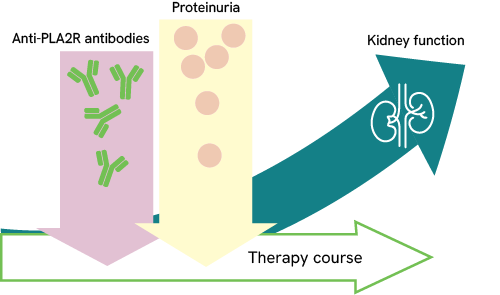Useful for both therapy and prognosis of membranous nephropathy
In addition to the primary diagnosis of the disease, a detection of autoantibodies against PLA2R (anti-PLA2R antibodies) allows assessment and monitoring of the disease course and the progress of a treatment.
Obviously, there is a clear relation between the concentration of anti-PLA2R antibodies in the blood of a patient and the course and activity of pMN. A high concentration of anti-PLA2R antibodies indicates an increased disease activity and the necessity of intensive treatment. The lower the originally detected anti-PLA2R concentration, the better are the prospects of successful treatment with immunosuppressives. In the course of such therapy, the patient's antibody concentration usually decreases rapidly – even faster than the proteinuria subsides.
 |
The concentration of anti-PLA2R antibodies also allows assessment of the course after kidney transplantation. Chances of complete improvement of the symptoms are greater, the lower the anti-PLA2R antibody concentration after the surgery is. A persistently detectable amount of anti-PLA2R antibodies in blood, however, can be identified as a significant risk factor for a recurrence of the pMN after organ transplantation.
Consequently, anti-PLA2R autoantibodies have a great value for diagnostics and treatment of pMN. Their concentration allows assessment of the disease activity, the required treatment and the chances of success of the therapy. Moreover, they have a high predictive value for the success of kidney transplantation.
The great advantage of antibody-based blood tests is also that they can be performed several times within a short period of time and thus help to prevent biopsies, which are complicated and stressful.

